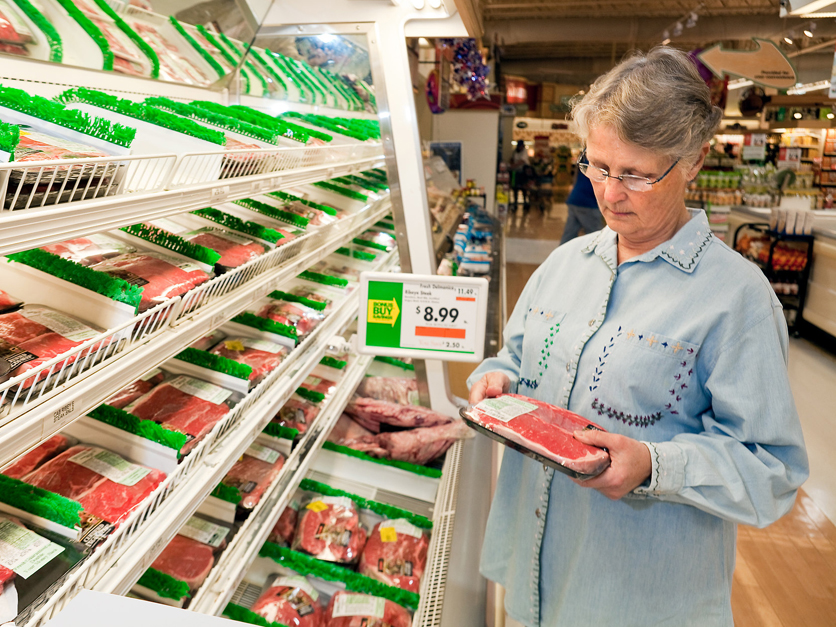Domestic meat and poultry consumption rose again in 2020 despite the COVID-19 pandemic and widespread disruptions to restaurants and food service, and the industry is watching to see if stimulus checks and the ongoing economic recovery can boost sales again this year.
The industry watched domestic consumption plunge after the 2008-2009 economic crisis, dropping from more than 220 pounds per person to nearly 200 pounds by 2014, but Americans have been finding their taste for meat again even as new plant-based alternatives started hitting the market.
In 2020, Americans consumed an average of 96.2 pounds of chicken, 58.4 pounds of beef, 52 pounds of pork, and 1.3 pounds of lamb, according to USDA. All of those were increases over 2017.
By comparison, in 2017, they ate 91.1 pounds of chicken, 57 pounds of beef, 50.2 pounds of pork, and 1.1 pounds of lamb. Turkey consumption was the only meat that saw a decline, going from 16.5 pounds in 2017 to 15.8 pounds in 2020.
USDA Chief Economist Seth Meyer said disposable income went up last year, providing an interesting data point to watch to determine if there is another increase that leads to increased meat consumption this year.

Seth Meyer, USDA
“Who knows how that stimulus turns into meat consumption,” Meyer told Agri-Pulse. “But those folks do need that strength of domestic demand that they saw last year.” Meyer asked whether once stimulus checks stop, does the industry then rely on gross domestic product to increase demand?
Last Wednesday, some 90 million economic stimulus payments were distributed to Americans, with millions more payments going out in the coming weeks, according to the Internal Revenue Service.
Meyer said the industry also needs solid export demand to use up some of the meat it's producing.
Tom Super, spokesperson for the National Chicken Council, said the rise in chicken consumption over the last few years is due to people buying more chicken wings and the “chicken sandwich wars” by food service companies.
“We’ve come to the conclusion that chicken wings are pandemic-proof food,” Super told Agri-Pulse. “We’ve seen consumption skyrocket in terms of the wings Americans are eating.”
Traditional pizza and wing restaurants were built for takeout, he said, so they didn’t have to change their business model much when the pandemic shut everything down.
NCC estimates Americans ate about 31 billion wing segments in 2020. Consumption of that specific cut has seen a steady 1% to 2% increase each year since 2017. On Super Bowl weekend alone this past year, Americans devoured an estimated 1.42 billion wings.
Super said online home delivery services have also helped boost sales, and he hopes chicken consumption will surpass 100 pounds per person by 2022.
Meanwhile, the number of people who are eating beef at least once a week rose in 2020 despite the pandemic, said Shawn Darcy, senior director of market research at the National Cattlemen’s Beef Association.
“Our average in 2019 was 66% of people saying they had beef at least weekly and that number has grown to 77%,” he told Agri-Pulse.
He said a lot of that was driven by the retail sector as people cooked more meals at home during the pandemic.
“There is a lot more volume, about 10% higher volume sold over this last year, which amounted to over $9 billion in sales growth in the fresh meat department alone,” he said. Darcy noted $6 billion of that was beef specifically.
Most of the retail sales are due to ground beef, which he said makes up about 40% of the volume.
Darcy said people likely won’t want to cook at home as much once pandemic restrictions loosen. He said approximately 61% of yearly sales are from food service. This year that number is closer to 55%.
“So, what does that look like for 2021? Does that fall in the 58% to 59% range instead of 61%?” he said. “Knowing that this is starting out a little slow, we would expect retail to take some of that (percentage) but eventually it probably will normalize.”
A separate report, issued by FMI and the Meat Institute Foundation and conducted by 210 Analytics, suggests that consumer acceptance of meat may be growing, with 94% saying they buy meat because it provides high quality protein.
“Americans feel better than ever about choosing meat as part of healthy, balanced diets. With COVID-19 deepening demand for convenient, affordable food that tastes good and matches Americans’ values, meat fits the bill,” noted NAMI President and CEO Julie Anna Potts.
Interested in more news on farm programs, trade and rural issues? Sign up for a four-week free trial to Agri-Pulse. You’ll receive our content - absolutely free - during the trial period.
Rick Stein, FMI’s vice president of fresh foods, said as consumers do more cooking at home, “their confidence in cooking and preparing meat has increased.”
“Further analysis also shows convenient meal solutions are key and that food retailers have opportunities to provide more choices, along with more information and education on consumer priorities like nutrition and meal preparation — building up what we call consumers’ Meat IQ,” he said.
Tara Dugan, director of consumer insights for the National Pork Board, said especially over the last year, pork sales have seen growth in both value and volume. According to research by Information Resources Inc., fresh pork sales for 2020 were up 18% by value and 11% in volume, she said.
For 2021, COVID-19 vaccination rates will play a role in demand shifts as people become more mobile, she said.
“We have seen that the year is off to a good start for fresh meat and fresh pork, but as folks start to get back out, we’re likely going to see some of those behaviors shift over to food service,” she said.
Dugan said the pandemic has also increased consumers' understanding of how to cook meat; they’ve became more comfortable preparing it after having spent so much time in the kitchen over the last year.
For more news, go to www.Agri-Pulse.com.


